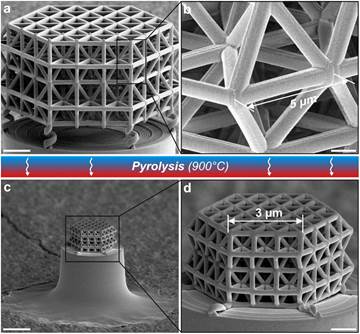Fabricating Lightweight and Ultrastrong Mechanical Metamaterials
In the search for materials that are both light and strong, classic material design—such as optimizing the chemistry and/or microstructure of bulk materials—has been systematically exploited over centuries, leaving limited room for further improvements. Although major advancements have been made with respect to mechanical strength and density, light materials generally remain weak and heavy materials strong; hence, the two properties have historically been considered to be connected. However, in recent years, the field of so-called ‘metamaterials’ (materials engineered to possess properties not usually found in nature) has made considerable advances in the development of materials that are both light and strong.
Metamaterials usually consist of assemblies of multiple repeating elements, and their special properties are primarily determined by their topology rather than their composition. Initially, these materials were designed to display unique optical, electromagnetic, or acoustic characteristics. Recently, mechanical metamaterials have also emerged, with principally opposing mechanical properties, such as both high stiffness and high damping (mechanical energy dissipation) capability or a negative Poisson's ratio (i.e., a material that expands laterally when stretched). In addition, a class of lightweight mechanical metamaterials has been developed, inspired by natural hierarchical cellular materials and triggered by the recent evolution of high-resolution 3D printing technologies that enable the miniaturization of lattice structures.
The properties of these lightweight metamaterials depend on the microscopic length scales of their patterns as well as their topologies. Because of their specifically designed architectures, these lattice materials reach remarkable strengths at low densities that might never be achieved using classic material design. When the lattices are scaled down dramatically, the solid materials they are composed of can exhibit pronounced size-dependent material strengthening effects, and several microscale lattice structures aiming to exploit these effects have been fabricated recently. However, their strength has largely been limited by the resolution of 3D manufacturing technologies and they have generally been restricted to only polymer materials. Moreover, the strength of current metallic, ceramic and composite microlattice metamaterials (synthesized from classic materials using post-processing techniques) is only slightly better than macroscopic lattices made from high-strength bulk materials.Here, we describe our recent work on the pyrolysis of polymeric microlattices, and show that current manufacturing resolution limits and material restrictions can be overcome to produce light and strong metamaterials.
We have recently fabricated ultrastrong glassy carbon nanolattices with single struts shorter than 1μm and diameters as small as 200nm (see Figure 1). In the initial step, polymer microlattices are printed in a photosensitive resin by 3D direct laser writing (a two-photon lithography process). The polymer lattices are then converted to glassy carbon by pyrolysis under vacuum at 900°C. The lattices shrink isotropically by ∼80% during this heat treatment, producing the smallest 3D printed lattice structures to date.
Figure 1. Scanning electron microscopy images of a glassy carbon nanolattice. (a,b) A polymer microlattice fabricated by 3D printing. (c,d) Vacuum pyrolysis transforms the polymer to glassy carbon and isotropically shrinks the lattice by ∼80%, producing a nanolattice. Lattice distortion during pyrolysis is eliminated by including pedestals and coiled spring supports, distancing the lattice from the substrate. Scale bars: (a,c) 5μm, (b,d) 1μm. Reproduced with permission.
These nanolattices show pronounced size-dependent strengthening effects, and hence exhibit material strengths up to 3000MPa. This is around 1/10 of the Young's modulus of glassy carbon and , therefore, corresponds to the theoretical strength of the material. By contrast, the strength of bulk glassy carbon (and the initial polymer) is below 100MPa. With effective strengths up to 1000MPa and densities of ∼0.3–0.6g/cm3 (well below that of liquid water), our nanolattice structures achieve strength-to-density ratios at least six times higher than those reported for microlattices and outperform almost all bulk materials. Indeed, diamond is the only bulk material with a notably higher strength-to-density ratio.
In summary, we have used 3D direct laser writing and pyrolysis to fabricate glassy carbon nanolattices with very high strength-to-density ratios. These nanolattices represent a significant step forward in the field of lightweight mechanical metamaterials. Ultimately, metamaterials of this type could result in a new age of stronger, tougher, lighter, and more-durable materials.
Additionally, taking 3D printing further into the nanoscale with pyrolysis has potential impacts far beyond the field of lightweight mechanical metamaterials, including for optical applications above the Abbe diffraction limit (i.e., the resolution limit for microscopes). Our future work in this area will include investigating opportunities for multifunctionality in these nanolattice structures as multiscale, hierarchical approaches may offer a whole new spectrum of characteristics and provide methods to scale up production to practical volumes of material.
(From:http://spie.org/newsroom/6832-fabricating-lightweight-and-ultrastrong-mechanical-metamaterials?highlight=x2402&ArticleID=x125839)

